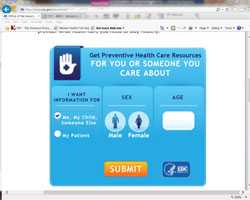Health Insurance Marketplace and Women
 Get helpful tips to enroll in a health plan, get the preventive services you need, and navigate the health system to stay healthy.
Get helpful tips to enroll in a health plan, get the preventive services you need, and navigate the health system to stay healthy.
Enroll in a Health Plan
The Marketplace is now open for 2017! Get health insurance through the Health Insurance Marketplace until January 31, 2017 and learn about free preventive services available to women. If you already have coverage through the Marketplace, learn about Coverage to Care and other resources to help you navigate the health care system.
In the Marketplace, you can:
- Compare different plans based on price, benefits, quality, and other features important to you
- Choose a combination of price and benefits that fit your budget and meet your needs
Most people are eligible for health coverage through the Marketplace, which is available in every state.
Get Preventive Screenings and Services
Women’s Preventive Health Services
Health insurance plans now allow women to get care for a host of preventive services. Marketplace plans (and many other plans) must offer these services at no cost to you. This means there is no charge for copayments or coinsurance, even if you haven’t met your deductible for the year. You must use a provider in your plan’s network to get these services for free.
Many preventive services for women are provided at no additional cost, including, but not limited to:
- Breast cancer screening (mammography) every 1 to 2 years for women over 40
- Breast cancer genetic test counseling (BRCA) for women at higher risk for breast cancer
- Cervical cancer screening (Pap test) for sexually active women
- Gestational diabetes screening for women 24 to 28 weeks pregnant and those at high risk of developing gestational diabetes
- HIV and STD screening and counseling for sexually active women
- Osteoporosis screening (bone density) for women over age 60 depending on risk factors
- Domestic and interpersonal violence screening and counseling for all women
- Well-woman visits to get recommended services for women under 65
- Contraception methods, sterilization procedures, and patient education and counseling
To learn more about these preventive services, please visit Health Care Reform: Women or Preventive Health Services for Women.
Navigate the System
Coverage to Care: Your Roadmap to Health
From Coverage to Care: A Roadmap to Better Care and a Healthier You is a resource to help you navigate the health care system. It provides eight simple steps on how to understand and use your coverage. You can also get helpful tips on primary care and preventive services, and learn ways for you and your family to stay healthy.
Topics covered and questions answered include:
- Put your health first. Why are prevention and health coverage important?
- Understand your health coverage. What words should I know? How much will it cost me to get care?
- Know where to go for care. Where do I go when I am sick? Where do I go for primary care?
- Find a provider. How do I find a provider that is right for me? What if I am assigned a provider?
- Make an appointment. What information do I need and what questions should I ask when making an appointment?
- Be prepared for the visit. What should I bring to the appointment? What questions should I ask during the visit?
- Decide if the provider is right for you. Is this a provider I can trust and work with? If not, what do I do?
- Next steps after your appointment. Now that you have found a provider and had your first visit, where do you go from here?
Please visit, From Coverage to Care: A Roadmap to Better Care and Healthier You[1.18 MB] for more information.
Additional Tools and Resources
Every year, the process of signing-up for coverage in the Health Marketplace gets simpler. You can even apply on your cell phone. Call 1-800-318-2596 or find free in-person help in your community by visiting LocalHelp.HealthCare.gov.

The myhealthfinder tool helps you find out which preventive services you or a loved one may need this year.
More Information
- Page last reviewed: November 28, 2016
- Page last updated: November 28, 2016
- Content source:
- CDC Office of Women's Health
- Page maintained by: Office of the Associate Director for Communication, Digital Media Branch, Division of Public Affairs




 ShareCompartir
ShareCompartir

